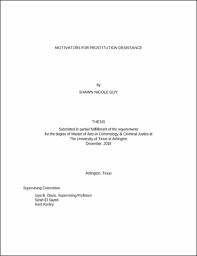
ATTENTION: The works hosted here are being migrated to a new repository that will consolidate resources, improve discoverability, and better show UTA's research impact on the global community. We will update authors as the migration progresses. Please see MavMatrix for more information.
Show simple item record
| dc.contributor.advisor | Davis, Jaya B. | |
| dc.creator | Guy, Shawn Nicole | |
| dc.date.accessioned | 2020-01-14T22:11:14Z | |
| dc.date.available | 2020-01-14T22:11:14Z | |
| dc.date.created | 2018-12 | |
| dc.date.issued | 2018-12-18 | |
| dc.date.submitted | December 2018 | |
| dc.identifier.uri | http://hdl.handle.net/10106/28888 | |
| dc.description.abstract | Abstract
The intent of this thesis was to determine the factors that lead to desistance from street prostitution in the form of motivators and how to shape recommendations to courts, social services, and policy-makers based off of identified themes. Additionally, various theories are discussed, supporting the presence of identified motivators and themes, that could be used by interventionsists as guiding principles when working on strategies for prostitution desistance modifications. Without isolating and stratifying motivators and themes, prostitutes who desire to desist may not receive appropiate treatments and interventions and may continue to recidivate with prostitution-related criminal charges. Statements obtained through qualitative interviews were given by desisting prostitutes enrolled in court-ordered programming (n=21) and were analyzed using an explantory, sequential mixed-method approach (Creswell & Plano Clark, 2011). The transcripts containing these statements were read to identify and code motivators and themes in which five prevailing outcomes were discovered to include age and maturation, new social networks, identity reconstruction, religious/spiritual activity, and long-term programming. It was found that without the acknowledgement and/or implementation of these features, desistance was unlikely to be sustained. In other words, for women in prostitution who are younger, remain in a criminogenic environment, adopt (or neglect to shed) a prostitute persona, who has no informal social controls in place and are not engaged in a formal specific programming, their chances of exiting prostitution would be minimal and their prospects of desistance would be improbable. While accounting for the above-mentioned outcomes, the motivators provided by the interviewed women revealed a combination of internal (intrinsic drive and maturation) and external (programming and faith-based exposure) aspects that existed within the desistance process. | |
| dc.format.mimetype | application/pdf | |
| dc.language.iso | en_US | |
| dc.subject | Prostitution desistance | |
| dc.title | Motivators of Prostitution Desistance | |
| dc.type | Thesis | |
| dc.degree.department | Criminology and Criminal Justice | |
| dc.degree.name | Master of Arts in Criminology and Criminal Justice | |
| dc.date.updated | 2020-01-14T22:13:24Z | |
| thesis.degree.department | Criminology and Criminal Justice | |
| thesis.degree.grantor | The University of Texas at Arlington | |
| thesis.degree.level | Masters | |
| thesis.degree.name | Master of Arts in Criminology and Criminal Justice | |
| dc.type.material | text | |
| dc.creator.orcid | 0000-0001-5229-669X | |
Files in this item
- Name:
- GUY-THESIS-2018.pdf
- Size:
- 635.1Kb
- Format:
- PDF
This item appears in the following Collection(s)
Show simple item record


